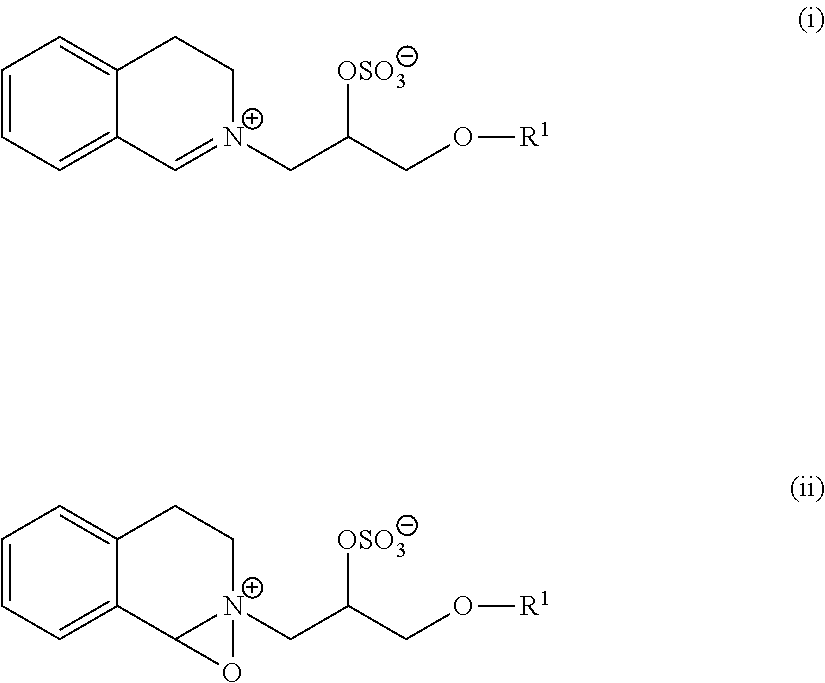Laundry detergent composition, method for washing and use of composition
- Summary
- Abstract
- Description
- Claims
- Application Information
AI Technical Summary
Benefits of technology
Problems solved by technology
Method used
Image
Examples
example 1
[0398]Cellulose degrading experiments are performed in order to assess the wash performance—degradation—on cellulose based material like cellulose fibres. One application is to clean the filters and pipes in the laundry washing machine. The cellulose fibres used in this evaluation have been collected from two sources, one from the filter from tumble dryers, in this case Miele SOFTTRONIC T8627 WP with the program Automatic+ and where 75% cotton and 25% polyester had been tumble dried and another one from paper tissues; KIMCARE, Medical Wipes, code 3020—Kimberly-Clark professional.
[0399]First the cellulose fibres are acid treated with 10 ml solution of citric acid (6 gram / liter) reaching a pH of about pH 2-3 in a beaker for about 10 minutes. After this, the cellulose fibres are placed on a sieve over a beaker for drying overnight at room temperature. The next day the dry cellulose fibres are placed in a beaker with water at 40° C. and the enzyme preparation 2 capable of degrading cell...
example 2
Tensile Strength Evaluation
[0400]Tensile strength evaluation is done in order to find out if the enzyme preparation 2 material used will degrade the cotton textiles too much so that it will be negative for a consumer using a commercial product containing the enzyme preparation 2 capable of degrading cellulosic. The tensile strength evaluation was performed at wfk Testgewebe GmbH, Germany. The determination of tensile strength is done according to ISO 13934 T01 and DIN 53919 part 2, see description below. Textile used is wfk 11A, 100% woven cotton.
Determination of Tensile Strength Loss According to DIN EN ISO 13934-1 and DIN 53919 Part 2
[0401]DIN 53919 part 1 describes the fabric construction of the wfk 11A and DIN 53919 part 2 describes how to prepare the specimen for each kind of test. DIN EN ISO 13934-1 describes testing conditions for tensile strength testing.
[0402]Repeated wash cycles usually reduce the tensile strength of the cotton control cloth due to the mechanical action an...
example 3
SEQ ID NO: 17 vs Enz 1—Full Scale Wash
[0421]This is a multicycle test (20 wash cycles) used to compare performance of SEQ ID NO: 1 versus the enzyme preparation of the invention in full scale wash under Latin American conditions (washing in a top loader washing machine). Fabrics and ballast are added to each wash together with laundry detergent composition and enzymes. After wash, fabrics were line dried. Fabrics appearance was evaluated visually by a group panel.
Equipment Used:
[0422]Washing machine: BWL11A Brastemp
[0423]The ballast consists of clean white cloth without optical whitener made of 100% cotton. The ballast weight, dryness and item composition must be the same in each wash. Ballast Example: (Standard LA ballast composition, total 1 kg)[0424]15 pieces 45×45 cm ballast 100% cotton
Wash Conditions
[0425]20 cycle test
Machine: TOP Load BWL11A Brastemp
[0426]Washing temperature (° C.): 25
Washing cycle: cycle “dia-a-dia” (normal)
[0427]1 h30 min washing cycle, with two rinsi...
PUM
| Property | Measurement | Unit |
|---|---|---|
| Fraction | aaaaa | aaaaa |
| Concentration | aaaaa | aaaaa |
| Concentration | aaaaa | aaaaa |
Abstract
Description
Claims
Application Information
 Login to View More
Login to View More - Generate Ideas
- Intellectual Property
- Life Sciences
- Materials
- Tech Scout
- Unparalleled Data Quality
- Higher Quality Content
- 60% Fewer Hallucinations
Browse by: Latest US Patents, China's latest patents, Technical Efficacy Thesaurus, Application Domain, Technology Topic, Popular Technical Reports.
© 2025 PatSnap. All rights reserved.Legal|Privacy policy|Modern Slavery Act Transparency Statement|Sitemap|About US| Contact US: help@patsnap.com

